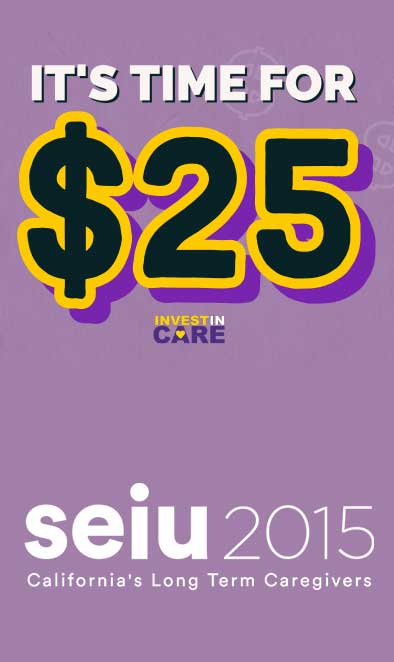Caregivers are the backbone of our community…
IT’S TIME FOR $25
— F A C T S H E E T —
For centuries, Black, brown, AAPI, Latina, indigenous and immigrant women have sustained the life of the nation, raising our children and providing life-saving care for seniors, people with disabilities and those recovering from injuries or illnesses. Yet these care providers continue to be among the most disrespected, unprotected and under-paid workers in the country.
Graying of America
- Home care is also the nation’s fastest-growing job sector, as roughly 10,000 Americans turn 65 each day.
- The U.S. will need to fill an estimated 4.7 million home care jobs, including over one million new jobs, by 2028.
- An investment in home- and community-based care would help meet the ballooning demand for care and establish a pipeline of home care workers into the next generation by transforming care jobs into good, living-wage, union jobs with training opportunities and real career pathways.
- A combined 92% of voters across party lines say long-term care should be a priority for the country, including a notable 67% who think it should be a high priority.
- To sustain the vital care that will only increase in need, we need to support this workforce with a livable wage.
The crisis for our community
- For in-home care providers, there’s an astronomical national turnover rate as high as 60% within the first year of service and 90% within the first two years.
- More than a quarter million care hours go unused in California, indicating a shortage of providers as the demand only grows.
…and then came COVID-19
- The pandemic laid bare how provider shortages can become deadly when a contagious disease quickly spreads.
- At the same time, underpaid, financially strapped direct care workers had few other options than to keep working during the coronavirus pandemic, even if it put at risk their own health and the health of their families, care recipients, and the public.
- Addressing low pay in the industry is a public health issue. Long-term care providers are forced to work multiple jobs in multiple homes.
The crisis for care providers
- Nationally, in-home care workers are 87% women, 62% people of color, and 31% are immigrants.
- In-home care providers across the state earn far below the hourly wages that MIT experts calculate it would take to cover basic living costs in California.
- As a result, 53% of home care workers are forced to rely on some form of public assistance just to survive and feed their families. This creates an astronomical turnover rate as mentioned above.
- Home care workers commonly lack health benefits, paid sick days, hazard pay or any training opportunities whatsoever.
- Home care workers have been continually—and intentionally—excluded from the protections enjoyed by other American workers. Home care workers are paid poverty wages, and commonly lack health benefits, paid time off, hazard pay or any training opportunities whatsoever. And in 41 states, many lack the right to collectively bargain.
The solution:
- In-Home Supportive Services (IHSS) workers have become increasingly essential to the California workforce, providing necessary care to residents across the state.
- Over the last few years, IHSS related employment has increased to over 716,000 positions across California.
